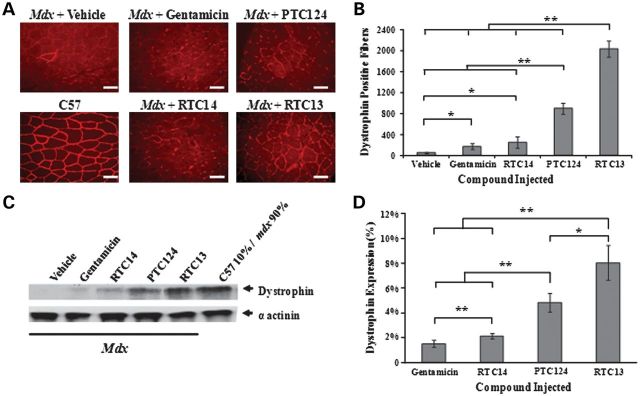Figure 3.

Single dose intramuscular injection of RTCs. (A) Dystrophin staining in TA muscles of mdx mice injected with RTC13, RTC14, gentamicin or PTC124 and analyzed 2 weeks after delivery of compounds and compared with muscles treated with DMSO alone. Dystrophin expression was evident in muscles that received RTC13 and, to a lesser extent, in muscles injected with PTC124 but not in sham-injected muscles. Weak expression was detected in TA muscles injected with gentamicin and RTC14. (N = 4 muscles per compound; scale bar: 50 µm). (B) The number of dystrophin-positive fibers was determined across the length of the muscle. TA injected with RTC13 showed a significantly higher number of positive fibers than muscles that received gentamicin, RTC14 or PTC124. Shown here is the average number of dystrophin-positive fibers per cross-sectional area containing the highest number of positives. (N = 4 muscles per compound; *P < 0.04; **P < 0.002). (C) Western blot analysis was used to detect full-length dystrophin expression in muscles injected with the compounds and analyzed for dystrophin 2 weeks later. Protein isolated from wild-type TA muscles was used as positive control to visualize dystrophin and was diluted with total protein isolated from mdx-untreated muscle (10% of total wild-type protein and 90% of total mdx protein for a final concentration of 250 µg). Here shown are the representative results of three independent experiments. (D) The level of dystrophin protein was significantly higher in muscles injected with RTC13 than those that received gentamicin, RTC14 and PTC124 (*P ≤ 0.03, **P ≤ 0.002).
